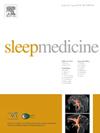History of symptoms consistent with REM sleep behavior disorder in a population with Parkinson's Disease
IF 3.8
2区 医学
Q1 CLINICAL NEUROLOGY
引用次数: 0
Abstract
REM Sleep Behavioral Disorder (RBD) is a parasomnia marked by the maintenance of muscle tone during REM sleep. Evidence has placed RBD as one of the possible prodromal stages of Parkinson's Disease (PD), but data on the proportion of people with PD who have had symptoms of RBD are limited. This study aimed to investigate the history of symptoms compatible with RBD in a population with PD. The sample was composed by 73 patients with clinically diagnosed PD being followed up at a reference outpatient setting, compared to 73 age- and sex-matched individuals with no PD. The evaluation of symptoms compatible with RBD was performed using the Brazilian version of the RBD Screening Questionnaire (RBDSQ). The prevalence of symptoms compatible with RBD was 65 % for PD and 10.09 % for controls. The RBDSQ score was significantly higher in the PD group (6.03 ± 0.35) in comparison to the control group (2.38 ± 0.23). The odds ratio for presenting previous RBD-compatible symptoms was 12.09 in favor of positive PD cases. PD diagnosis has the following diagnostic properties in relation to presenting RBD symptoms: sensitivity of 0.65, specificity of 0.86, positive predictive value of 0.82 and negative predictive value of 0.71. In conclusion, the proportion of PD patients showing RBD symptoms is high, corroborating the expected neuroprogression of the disease on a case-control design comprising outpatient PD cases. Clinical practitioners should include evaluations of RBD-compatible symptoms during the PD assessment and, if positive, forward to a sleep specialist.
帕金森病患者的快速眼动睡眠行为障碍症状史。
快速眼动睡眠行为障碍(RBD)是一种以快速眼动睡眠期间肌肉张力维持为特征的寄生虫性失眠症。有证据表明,RBD 是帕金森病(PD)可能的前驱阶段之一,但关于帕金森病患者中出现过 RBD 症状的比例的数据却很有限。本研究旨在调查帕金森病患者中出现与 RBD 相符的症状的病史。样本由 73 名在参考门诊接受随访的临床诊断为帕金森病的患者和 73 名年龄和性别匹配的非帕金森病患者组成。研究人员使用巴西版的RBD筛查问卷(RBDSQ)对符合RBD的症状进行了评估。在帕金森病患者中,RBD 症状的发生率为 65%,而在对照组中为 10.09%。与对照组(2.38 ± 0.23)相比,帕金森病组的 RBDSQ 得分明显更高(6.03 ± 0.35)。阳性的帕金森氏症病例中,出现与 RBD 相符的症状的几率比为 12.09。就出现 RBD 症状而言,PD 诊断具有以下诊断特性:敏感性为 0.65,特异性为 0.86,阳性预测值为 0.82,阴性预测值为 0.71。总之,显示 RBD 症状的帕金森病患者比例很高,这证实了由门诊帕金森病病例组成的病例对照设计所预期的疾病神经进展。临床医师在进行帕金森病评估时应包括对 RBD 症状的评估,如果结果呈阳性,应将其转至睡眠专科医师。
本文章由计算机程序翻译,如有差异,请以英文原文为准。
求助全文
约1分钟内获得全文
求助全文
来源期刊

Sleep medicine
医学-临床神经学
CiteScore
8.40
自引率
6.20%
发文量
1060
审稿时长
49 days
期刊介绍:
Sleep Medicine aims to be a journal no one involved in clinical sleep medicine can do without.
A journal primarily focussing on the human aspects of sleep, integrating the various disciplines that are involved in sleep medicine: neurology, clinical neurophysiology, internal medicine (particularly pulmonology and cardiology), psychology, psychiatry, sleep technology, pediatrics, neurosurgery, otorhinolaryngology, and dentistry.
The journal publishes the following types of articles: Reviews (also intended as a way to bridge the gap between basic sleep research and clinical relevance); Original Research Articles; Full-length articles; Brief communications; Controversies; Case reports; Letters to the Editor; Journal search and commentaries; Book reviews; Meeting announcements; Listing of relevant organisations plus web sites.
 求助内容:
求助内容: 应助结果提醒方式:
应助结果提醒方式:


